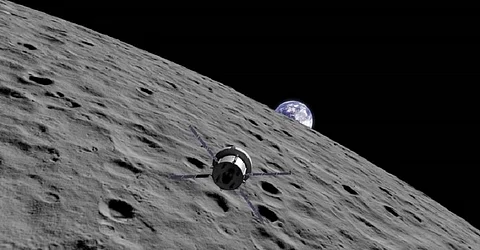

The Moon could be sourcing water from Earth, according to a new report.
Hydrogen and oxygen from Earth combine to form water on the Moon, the theory published in Scientific Reports suggested. This process may have created up to 3,500 cubic kilometres of surface permafrost (water ice) or subsurface liquid water, the study estimated.
The theory has its roots in the earth’s magnetic field, according to the study. As the moon orbits the Earth, it passes through the magnetosphere, a vast comet-sized bubble around the planet created by the earth’s magnetic field. It keeps the solar material from entering the earth, according to the United States National Aeronautics and Space Administration (NASA).
Some of Earth’s magnetic field lines break and trail off into space for thousands of miles, Gunther Kletetschka, associate research professor at the University of Alaska Fairbanks Geophysical Institute, told Down to Earth (DTE).
The magnetosphere vigorously flaps like a flag in the wind in response to the pressure from the solar wind, the expert highlighted. It compresses on the dayside of Earth and stretches into a long tail on the night side, according to NASA.
The Moon, during its transit, is completely submerged inside the Earth's magnetic field, Kletetschka said. “And that got me kept thinking about how the Moon should feel in such a strange magnetic environment.”
As it passes through the long tail, some of these broken field lines reconnect with their opposing broken counterpart, the researchers wrote in their study.
During this time, oxygen and hydrogen ions in the upper parts of the atmosphere (ionosphere), between 80 kilometres and 600 km above the surface, move towards the reconnected lines, according to the status.
The presence of water-forming ions as the moon transits through this part of the magnetosphere was established by data from NASA, the European Space Agency, the Japan Aerospace Exploration Agency and the Indian Space Research Organization.
Some of these ions return to the earth and are likely to fall on the moon, the report said.
Kletetschka said in a statement:
It is like the moon is in the shower — a shower of water ions coming back to Earth, falling on the moon’s surface
These ions may combine to form lunar permafrost. Alternatively, they may be pushed below the surface to form liquid water, according to the researchers.
Previously, scientists speculated that the water reached the Moon through icy comets that crashed into its surface. Another popular theory suggested that interactions of lunar dust with the solar wind — charged particles from the sun’s upper atmosphere — could have created this essential resource.
“Each of these theories formulates a possible pathway for how the water can be deposited on the Moon, and they are all based on realistic models,” Kletetschka said.
“Our approach allows for a new source of water that may be applicable not only for our Moon but also for moons around other planets with magnetic fields like Jupiter, for example,” he added.
NASA’s SOFIA mission detected water molecules on the sunlit regions of the Moon. The presence of this resource could enable future explorers to set up camps on the lunar body. NASA’s Artemis project plans to send the first woman and the next man to the moon in this decade.
Future human missions to the Moon could allow researchers to test this new theory proposed by Kletetschka and his team. When water on the Moon is collected, it would contain a specific isotopic signature that may provide a clue about its origin, Kletetschka added.